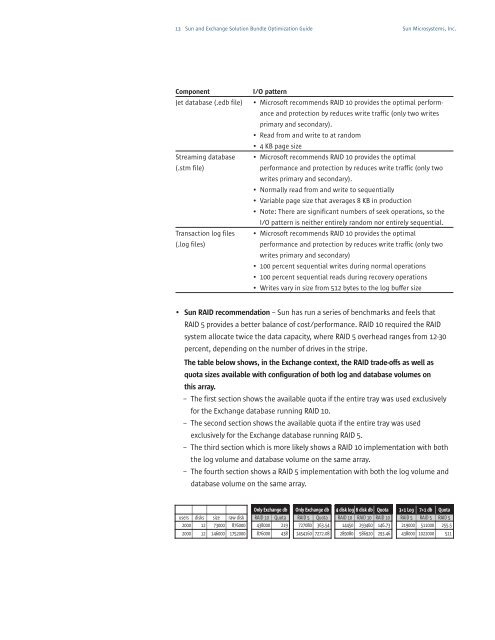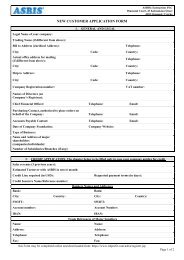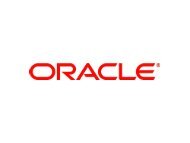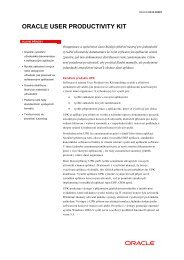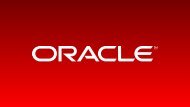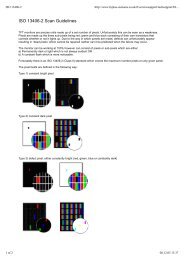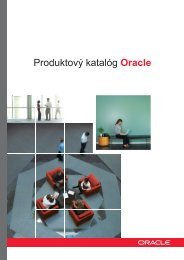sun and exchange solution bundles - ASBIS SK Online
sun and exchange solution bundles - ASBIS SK Online
sun and exchange solution bundles - ASBIS SK Online
You also want an ePaper? Increase the reach of your titles
YUMPU automatically turns print PDFs into web optimized ePapers that Google loves.
13 Sun <strong>and</strong> Exchange Solution Bundle Optimization Guide<br />
Sun Microsystems, Inc.<br />
Component<br />
Jet database (.edb file)<br />
Streaming database<br />
(.stm file)<br />
Transaction log files<br />
(.log files)<br />
I/O pattern<br />
• Microsoft recommends RAID 10 provides the optimal performance<br />
<strong>and</strong> protection by reduces write traffic (only two writes<br />
primary <strong>and</strong> secondary).<br />
• Read from <strong>and</strong> write to at r<strong>and</strong>om<br />
• 4 KB page size<br />
• Microsoft recommends RAID 10 provides the optimal<br />
performance <strong>and</strong> protection by reduces write traffic (only two<br />
writes primary <strong>and</strong> secondary).<br />
• Normally read from <strong>and</strong> write to sequentially<br />
• Variable page size that averages 8 KB in production<br />
• Note: There are significant numbers of seek operations, so the<br />
I/O pattern is neither entirely r<strong>and</strong>om nor entirely sequential.<br />
• Microsoft recommends RAID 10 provides the optimal<br />
performance <strong>and</strong> protection by reduces write traffic (only two<br />
writes primary <strong>and</strong> secondary)<br />
• 100 percent sequential writes during normal operations<br />
• 100 percent sequential reads during recovery operations<br />
• Writes vary in size from 512 bytes to the log buffer size<br />
• Sun RAID recommendation – Sun has run a series of benchmarks <strong>and</strong> feels that<br />
RAID 5 provides a better balance of cost/performance. RAID 10 required the RAID<br />
system allocate twice the data capacity, where RAID 5 overhead ranges from 12-30<br />
percent, depending on the number of drives in the stripe.<br />
The table below shows, in the Exchange context, the RAID trade-offs as well as<br />
quota sizes available with configuration of both log <strong>and</strong> database volumes on<br />
this array.<br />
– The first section shows the available quota if the entire tray was used exclusively<br />
for the Exchange database running RAID 10.<br />
– The second section shows the available quota if the entire tray was used<br />
exclusively for the Exchange database running RAID 5.<br />
– The third section which is more likely shows a RAID 10 implementation with both<br />
the log volume <strong>and</strong> database volume on the same array.<br />
– The fourth section shows a RAID 5 implementation with both the log volume <strong>and</strong><br />
database volume on the same array.<br />
users disks size raw disk<br />
2000 12 73000 876000<br />
2000 12 146000 1752000<br />
Only Exchange db<br />
RAID 10 Quota<br />
438000 219<br />
876000 438<br />
Only Exchange db<br />
RAID 5 Quota<br />
727080 363.54<br />
1454160 7272.08<br />
4 disk log 8 disk db Quota<br />
RAID 10 RAID 10 RAID 10<br />
14450 293460 146.73<br />
289080 586920 293.46<br />
3+1 Log 7+1 db Quota<br />
RAID 5 RAID 5 RAID 5<br />
219000 511000 255.5<br />
438000 1022000 511


